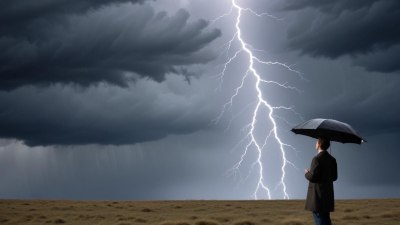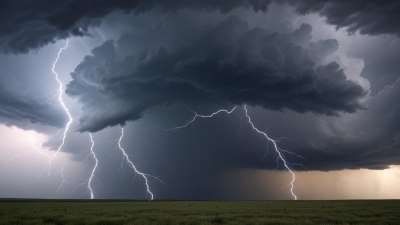The Science of Weather-Related Phobias
Explore the psychological and physiological aspects of weather-related phobias and their impact on individuals.

This image was created with the assistance of Freepik
Weather-related phobias are an intriguing area of study within psychology. These phobias can manifest in various ways, often leading to significant distress for those affected. Understanding the science behind these fears is essential in addressing and alleviating the consequences for individuals. This article delves into the most common weather-related phobias, their underlying causes, and potential treatment options. Through a comprehensive look at the intersection of weather and mental health, we aim to shed light on how these phobias develop and how people confront them.
What Are Weather-Related Phobias?
Weather-related phobias, also known as 'meteophobia' or specific phobias like 'astraphobia' (the fear of thunder and lightning) or 'hydrophobia' (the fear of flood or large bodies of water), are intense, irrational fears associated with specific weather phenomena. Individuals suffering from these phobias may experience anxiety, panic attacks, and significant avoidance behaviors whenever they encounter situations related to their fear. These phobias can severely limit their quality of life, making it challenging to perform everyday activities, travel, or engage with nature.
Common Types of Weather-Related Phobias
Some of the most prevalent weather-related phobias include:
- Astraphobia: The fear of thunder and lightning, often triggered by loud noises or stormy weather.
- Chionophobia: The fear of snow, which can arise from concerns about being trapped in snow or experiencing cold-related injuries.
- Nephophobia: The fear of clouds, often associated with feelings of dread or impending danger during cloudy weather.
- Pluviophobia: The fear of rain, which can lead to avoidance of outdoor activities during rainy seasons.
- Hydrophobia: While often referred to as the fear of water, in the context of weather, it can refer to the fear of floods or drowning during heavy rains.
Psychological Factors Contributing to Weather-Related Phobias
Various psychological factors can contribute to the development of weather-related phobias. These may include:
- Traumatic Experiences: Past traumatic events related to severe weather, such as natural disasters, can lead to the development of phobias. Individuals who have experienced hurricanes, tornadoes, or severe storms may become overly fearful of future occurrences.
- Genetic Predisposition: Research suggests that certain individuals may have a genetic predisposition to anxiety disorders, making them more susceptible to developing phobias.
- Environmental Influences: Growing up in environments where weather-related trauma is prevalent can significantly influence the likelihood of developing these phobias. For example, children who frequently witness severe storms may develop a heightened fear of similar events.
- Learned Behaviors: Observing caregivers or peers exhibit fear towards specific weather conditions can teach children to adopt similar fears.
Biological Responses to Weather-Related Phobias
The body’s physiological response to weather-related phobias can vary significantly among individuals. Typically, when faced with a feared weather condition, individuals may experience a rapid heart rate, shortness of breath, sweating, trembling, and gastrointestinal distress. These reactions are the body’s natural fight-or-flight response to perceived danger. For people with weather phobias, this response can be disproportionately heightened compared to the actual risk presented by the weather phenomenon.
Diagnosis and Treatment of Weather-Related Phobias
Diagnosing weather-related phobias commonly involves a thorough assessment by a mental health professional. They may utilize diagnostic criteria from the DSM-5, which outlines specific characteristics of phobias, including intense fear or anxiety triggered by the actual or anticipated presence of the feared object or situation.
Treatment options for weather-related phobias often involve therapeutic approaches aimed at reducing anxiety and helping individuals cope with their fears. Common treatment methods include:
- Cognitive Behavioral Therapy (CBT): CBT is a widely used therapeutic approach that focuses on identifying and restructuring negative thought patterns associated with the phobia. Through gradual exposure to feared weather conditions, individuals can learn to manage their anxiety and ultimately reduce their fear.
- Exposure Therapy: This technique involves gradual exposure to the feared weather condition in a controlled, safe environment. Over time, individuals can become desensitized to their fears, ultimately leading to reduced anxiety levels.
- Medication: In some cases, medications may be prescribed to help manage anxiety symptoms. Antidepressants and anti-anxiety medications can be effective in reducing the overall intensity of an individual’s phobia.
- Mindfulness and Relaxation Techniques: Incorporating mindfulness practices, such as meditation or deep-breathing exercises, can help individuals manage anxiety symptoms and improve overall well-being.
The Role of Education and Awareness
Educating individuals about the science of weather-related phenomena can play a crucial role in alleviating fears. Understanding the mechanics of storms, for instance, can demystify weather events and reduce anxiety levels. Schools, community programs, and online platforms can all serve as essential resources for increasing awareness and knowledge about weather-related issues.
Conclusion
Weather-related phobias can deeply impact the lives of those affected, making it challenging to navigate daily living. Recognizing the psychological and biological factors that contribute to these fears is essential in creating effective treatment options. Through research, therapeutic interventions, and education, individuals can work towards overcoming their weather-related phobias and reclaiming control over their lives. Whether through therapy, support groups, or self-help strategies, the path to overcoming these fears is achievable, enabling individuals to engage more fully with the world around them.











